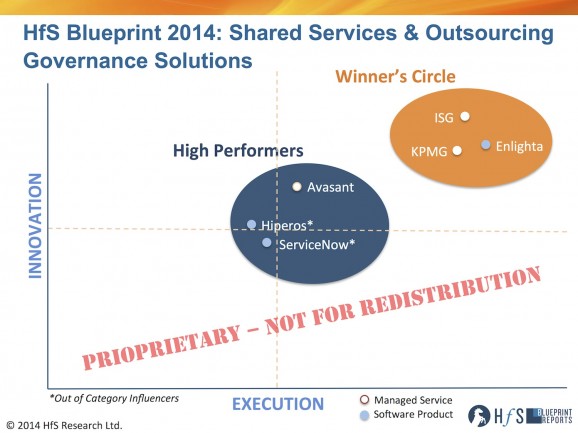The act of “outsourcing” is really only that initial phase of activity where an organization takes a technology/business process or function and transfers the management responsibility over to a third party to ensure the smooth running of said process or operation.
Once the outsourced processes are running functionally with the third party, the “outsourcing” is now complete and those activities on the buy-side become “service governance” activities, and the third party provider is delivering a “service” or an “operation” to its client.
The clients’ needs now fit into a set of governance functions that are centered on managing the provider relationship(s); communicating with – and reporting to – the internal business units and various stakeholders; aggregating, analyzing and reporting the appropriate performance and process metrics; managing risk, compliance and issue escalations. The more sophisticated and experienced the governance unit becomes, the more of a high value consultative entity the team can become for their organization as it seeks to centralize more operations under the governance function and align them to the business goals.
Simply put, an increasing number of mature enterprises governance teams are doing a lot more than managing vendors and periodically bashing them up to lower their rates – they are using advanced software platforms that help drive real value, continuous improvement and insight from the operations under their oversight. Most clients need realtime support to help them do this, and a small handful of ambitious advisors are developing managed governance services functions to support this need.
So we tasked our resident governance guru, Mike Beals, to venture in into the post-outsourcing transaction services industry to develop an HfS Blueprint Report that evaluates the managed services and software solutions available today that support clients managing their global shared services and outsourcing operations. And here is how they shook out:
So, Mike, what exactly are these Governance Solutions providers?
HfS Research defines Governance Solutions as the set of software applications or managed services focused on the management and optimization of shared services and outsourcing service delivery environments for business service functions.
These software applications and/or services are one level of management removed from operational delivery management tools and services. For example, an enterprise that uses a Service Management Software (SMS) tool like Remedy, Tivoli or ServiceNow for operational management still needs a tool or service to manage the complexities of a commercial outsourcing relationships and their peculiar methodologies.
Based on your many client interactions, why are Governance Solutions needed in this market today?
First, let’s start with some of the trends we see impacting the shared services and outsourcing industry, then I’ll drill into the answer. The big trends we saw in 2013 and confirmed in the 2014 State of Outsourcing Study are rapid adoption of GBS, or at least a hybrid delivery model, a shortage of skilled talent, and the desire to accomplish more strategic objectives than in the past.
Without delving into too much detail about those trends, the implications to overall enterprise SSO governance capability is the need for consistency in the way shared service and outsourcing environments are managed. Going forward, enterprises can’t afford to let each governance group define and execute governance its own way based on who’s in the group.
Because of the hybrid model most enterprises are adopting, the number of data sources has grown dramatically. Governance needs a way to aggregate that data into a structured repository. Without this ability, providing end-to-end service level and organization-specific financial reporting and analytics is virtually impossible.
Descriptive analytics that tell you what happened have been available for quite some time, but predictive and prescriptive analytics that forecast what will happen and what you should do about it are incredibly important to accomplishing the strategic objectives enterprises seek.
To address the talent shortage, enterprises must fully leverage their available resources. Since a significant portion of the work of governance is routine in nature, it can be automated. That frees up limited staff to focus on higher value activities like collaborating with service providers or consulting with the business.
Governance Solution providers, whether delivered via software or services, help address each of these challenges.
What capabilities do these Governance Solutions bring to enterprises?
Depends a bit whether they are a product company or a services company. Software firms can assist by taking documented governance process flows and enabling them using workflow. All of the business rules and decisions are codified, so when key team members move on to other jobs, their knowledge is retained and leveraged. Additionally, this drives consistency across multiple governance groups if they use the same core processes and only configure procedures peculiar to their environment.
The benefits of automation can also be significant. For example, these software applications, once configured, can extract source data from operational systems, calculate service levels, determine consumption buy business units, create pro forma invoices for verification, and many other routine, but time consuming tasks. Governance tools can also automate a huge percentage of the associated reporting requirements.
Governance software tools also provide a repository for all agreements and governance forms. Having a full-text searchable, secure, version controlled repository can save a huge amount of time and effort, particularly when you are reporting on that information or status.
From a managed governance services (MGS) perspective, each of these providers leverages an enabling platform and provides additional services to compliment the software capabilities we just discussed. Additional services range from governance staff augmentation, to providing compliance and risk audits, to offering coaching, to providing strategic sourcing recommendations based on industry trends or proprietary market benchmark data. There are a number of options to quickly improve a governance group’s overall capability and maturity.
So… who are the leading providers and what differentiates them?
Enlighta, ISG, and KPMG are the top providers in this year’s Blueprint Axis. Enlighta offers a software application called Govern that provides comprehensive governance functionality. It is the most robust and flexible tool that we evaluated in this study. Enlighta also offers another product, Deliver, that actually runs on the same platform as Govern, that competes in the Service Management Software (SMS) category against products like Remedy and Tivoli. A key differentiator is that enterprises seeking an integrated service management and delivery platform for their business service functions can go with Enlighta.
ISG (formerly TPI) has been in the sourcing advisory space since the beginning. They were also the first to offer managed governance services to their clients. Their approach has been to partner with various tool providers to create an enabling platform configuration unique to each client. Some of the software partners include Enlighta, StatusGreen, Apptio, and Blazent into what they call “ISG Labs.” The ISG Managed Governance group offers managed governance services as well as Service Integration and Management (SIAM) services.
KPMG’s Managed Governance Services (MGS) offerings originated at EquaTerra, which was acquired by KPMG in 2011. EquaTerra had a proprietary governance platform called EquaSiis Enterprise that was sold as a software application. When EquaTerra, and EquaSiis, was acquired by KPMG a managed governance group was formed that leveraged EquaSiis Enterprise, now renamed Governance Workplace. The KPMG MGS group leverages the comprehensive functionality of Governance Workplace with a well trained staff to provide as set of very competitive services to Information Technology and non-IT business service clients alike. As you would imagine as part of an audit firm, particular attention and functionality on risk management is emphasized.
And finally, what are the key takeaways you would like to leave us with?
There are many, but let me focus on three. First, risk and compliance are having an increasingly important impact on governance and these solution providers. The increasing amount of regulatory requirements, and the specificity on outsourcing governance means that these governance solutions, both products and services alike, are investing in risk and compliance functionality and capabilities.
Second, there is blurring of the lines between Service Management Software (SMS) products and governance tools/services — both categories of products access the same data, but for slightly different purposes. We see the potential for SMS products to move into this space via acquisition, or building out specific outsourcing governance functionality into their existing products.
Third, analytics is becoming increasingly important. As companies shift their sourcing objectives from tactical to strategic, having access to sophisticated analytics will be critical. We believe that governance solutions that provide this functionality will be a key success factor in the ability of enterprises to mature their overall governance capability.
Mike, we really appreciate learning from your experiences and research into the emerging Governance Solutions marketplace and look forward to reading more of your insights from the HfS Governance Institute. HfS readers can click here to view highlights of all our current 16 HfS Blueprint reports.
HfS subscribers click here to access the new HfS Blueprint Report, “Shared Services & Outsourcing Governance Solutions”
Posted in : Business Process Outsourcing (BPO), Captives and Shared Services Strategies, Cloud Computing, Global Business Services, HfS Blueprint Results, HfSResearch.com Homepage, IT Outsourcing / IT Services, kpo-analytics, Outsourcing Advisors, SaaS, PaaS, IaaS and BPaaS, Security and Risk, smac-and-big-data, Sourcing Best Practises









A nice article and a good overview on the offerings in IT and sourcing governance.
Although still not as large as the ones mentioned above, I would want to draw attention to upcoming, innovative tools with exactly the focus on an efficient and higly automated governance of IT sourcing. Thanks to venture capital and forward thinking customers our SaaS tool “Outsourcing Director” is in operations for several years now: http://www.plixos.com/en/products/outsourcing-director. Based on this online tool which is embedded in an end to end toolchain ranging from strategy to tendering to governance, we offer a fitting combination of tools plus expert advice and operational consulting in form of “Sourcing Advisory as a Service SAaaS(R)”: http://www.plixos.com/en/it-outsourcing-services/saaas-sourcing-advisory-as-a-service
[…] (Cross-posted @ Horses for Sources) […]